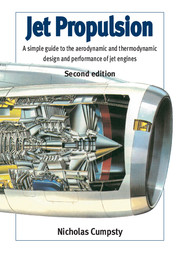 Jet Propulsion
Jet Propulsion Book contents
- Frontmatter
- Contents
- Preface
- Glossary
- Nomenclature
- Part 1 Design of Engines for a New 600-seat Aircraft
- Part 2 Engine Component Characteristics and Engine Matching
- Part 3 Design of Engines for a New Fighter Aircraft
- Part 4 Return to the Civil Transport Engine
- Appendix: Noise and its Regulation
- Bibliography
- References
- Index
- Design sheets for New Large Civil Aircraft and New Fighter Aircraft
Appendix: Noise and its Regulation
- Frontmatter
- Contents
- Preface
- Glossary
- Nomenclature
- Part 1 Design of Engines for a New 600-seat Aircraft
- Part 2 Engine Component Characteristics and Engine Matching
- Part 3 Design of Engines for a New Fighter Aircraft
- Part 4 Return to the Civil Transport Engine
- Appendix: Noise and its Regulation
- Bibliography
- References
- Index
- Design sheets for New Large Civil Aircraft and New Fighter Aircraft
Summary
History and regulation
As jet air transport increased in the 1960's the annoyance to people living and working around major airports was becoming intense. Regulations affecting international air transport are governed by the International Civil Aviation Organisation (icao), but this body was moving so slowly that in 1969 the US Federal Aviation Agency (faa) made proposals for maximum permitted noise levels. After extensive discussions in the USA these were formally approved as Federal Aviation Regulation (FAR) Part 36 in 1971, retroactive with effect from 1969, but only for new aircraft. Shortly afterwards the icao Committee on Aircraft Noise published similar recommendations, to be known as Annex 16, a formal addendum to the 1944 Chicago Convention on Civil Aviation; each member state had then to accept the rules in Annex 16 and write them into their legal framework. The underlying principle for the noise certification of aircraft under FAR Part 36 and Annex 16 are similar and has remained unchanged ever since, with the levels under the US and icao rules subsequently becoming virtually identical.
The certification for noise relies on measurements at three positions, two for take off (referred to as lateral and flyover) and one for landing (referred to as approach). The levels are expressed in decibels (EPNdB) using effective perceived noise level (EPNL), described in outline below. The layout for testing is shown in Fig. A1.
- Type
- Chapter
- Information
- Jet PropulsionA Simple Guide to the Aerodynamic and Thermodynamic Design and Performance of Jet Engines, pp. 289 - 296Publisher: Cambridge University PressPrint publication year: 2003


